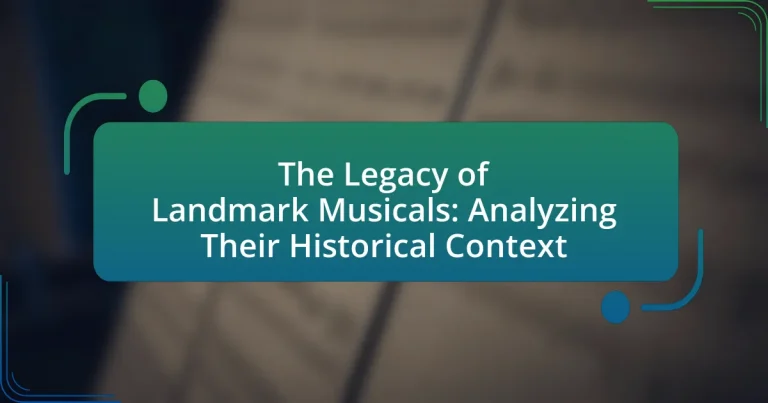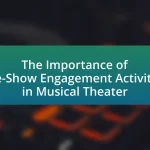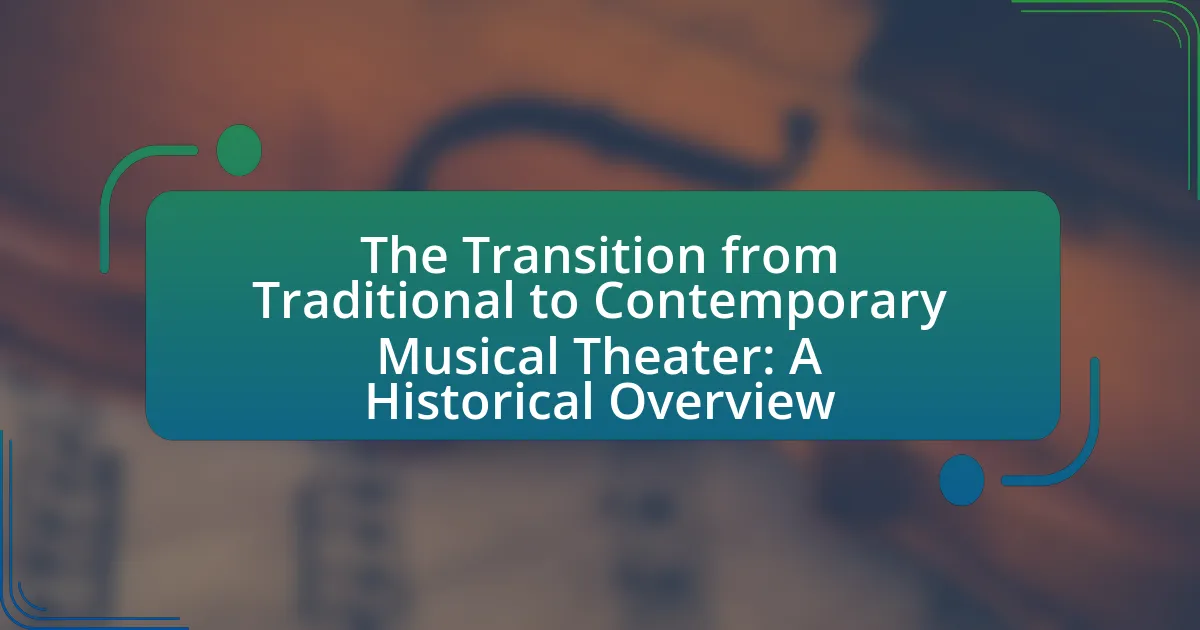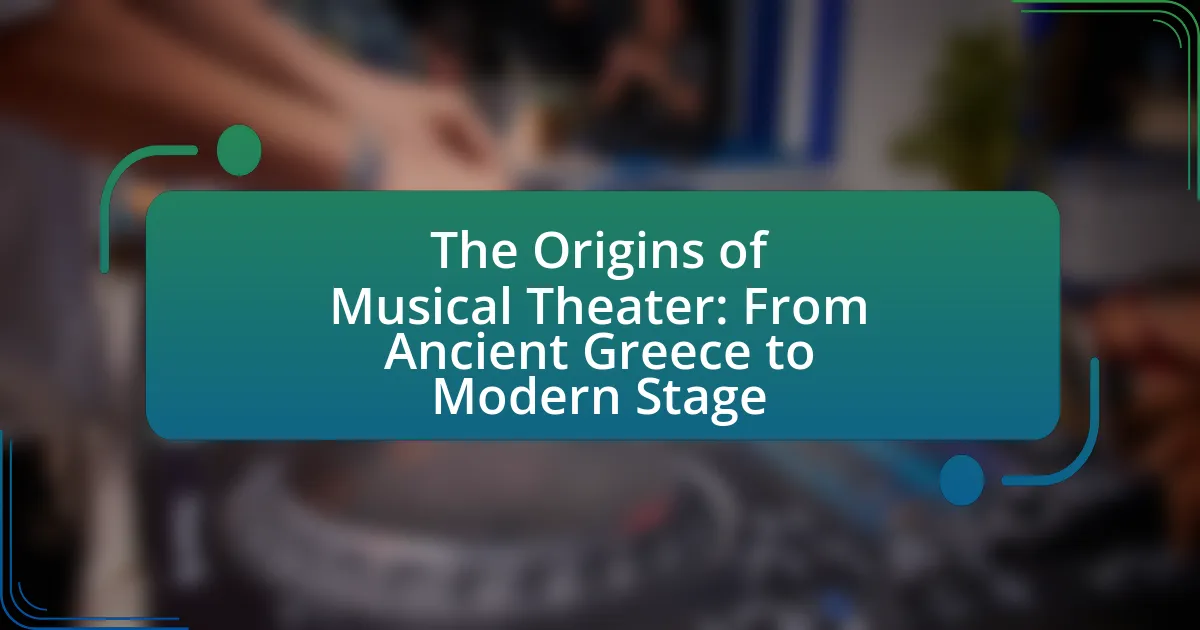The article examines the legacy of landmark musicals, focusing on their historical context and cultural impact. It highlights how productions like “West Side Story,” “Hamilton,” and “Rent” have reshaped musical theatre by addressing social issues, incorporating diverse musical styles, and utilizing innovative storytelling techniques. The discussion includes the influence of societal changes on the themes of these musicals, their role in cultural movements, and the significance of historical context in analyzing their narratives. Additionally, the article explores the key characteristics of landmark musicals, the prevalent themes they address, and the innovations that have emerged from their legacy, providing a comprehensive overview of their enduring relevance in contemporary society.
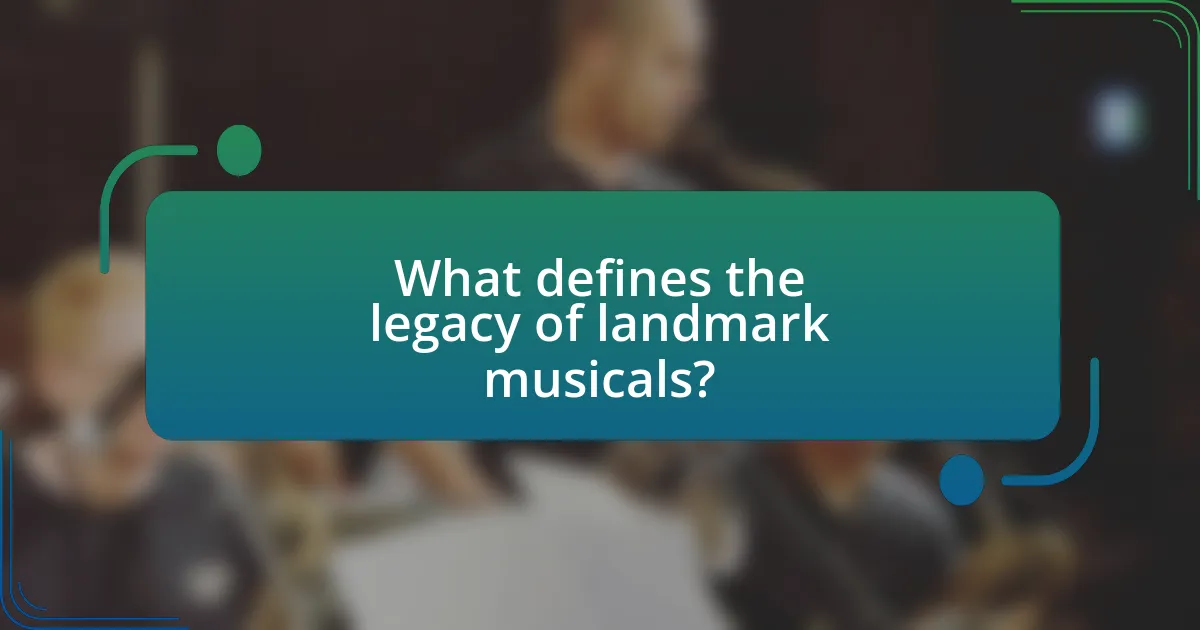
What defines the legacy of landmark musicals?
The legacy of landmark musicals is defined by their cultural impact, innovation in storytelling, and influence on subsequent works. Landmark musicals, such as “West Side Story” and “Hamilton,” have reshaped the musical theatre landscape by addressing social issues, incorporating diverse musical styles, and utilizing groundbreaking choreography. For instance, “West Side Story” introduced a fusion of classical music and jazz, while “Hamilton” revolutionized the genre by blending hip-hop with traditional musical elements, reflecting contemporary societal themes. These innovations not only captivated audiences but also set new standards for artistic expression in theatre, ensuring their enduring relevance and inspiring future generations of artists.
How have landmark musicals influenced cultural movements?
Landmark musicals have significantly influenced cultural movements by addressing social issues, shaping public discourse, and inspiring activism. For instance, “Rent” highlighted the struggles of the LGBTQ+ community and the impact of the AIDS crisis, fostering greater awareness and acceptance during the 1990s. Similarly, “Hamilton” redefined narratives around race and representation in America, sparking discussions about diversity and inclusion in the arts and beyond. These musicals not only reflect societal changes but also catalyze movements by engaging audiences emotionally and prompting them to take action, as evidenced by the increased visibility of social justice initiatives following their releases.
What specific musicals are considered landmark and why?
“West Side Story,” “Hamilton,” and “The Phantom of the Opera” are considered landmark musicals due to their innovative storytelling, cultural impact, and musical composition. “West Side Story,” created by Leonard Bernstein and Stephen Sondheim in 1957, revolutionized the integration of music and dance with its modern retelling of Romeo and Juliet, addressing social issues like gang violence and racism. “Hamilton,” written by Lin-Manuel Miranda in 2015, transformed the musical landscape by incorporating hip-hop and diverse casting to tell the story of America’s founding fathers, making history accessible and relevant to contemporary audiences. “The Phantom of the Opera,” composed by Andrew Lloyd Webber and premiering in 1986, is notable for its grand scale, elaborate staging, and memorable score, becoming the longest-running show in Broadway history and influencing the development of musical theater worldwide. These musicals not only pushed artistic boundaries but also reflected and shaped societal conversations during their respective eras.
How did societal changes shape the themes of these musicals?
Societal changes significantly shaped the themes of landmark musicals by reflecting and responding to the evolving cultural, political, and social landscapes. For instance, the civil rights movement influenced musicals like “Hair,” which addressed issues of race and counterculture, while “Rent” highlighted the struggles of marginalized communities during the AIDS crisis. These musicals incorporated contemporary issues, such as gender equality and economic disparity, demonstrating how societal shifts directly informed their narratives and character development. The incorporation of these themes not only resonated with audiences but also served as a catalyst for broader discussions on social justice and identity, illustrating the powerful interplay between societal changes and musical storytelling.
Why is historical context important in analyzing musicals?
Historical context is important in analyzing musicals because it provides insight into the social, political, and cultural influences that shape the themes and narratives of the work. Understanding the era in which a musical was created allows for a deeper appreciation of its commentary on contemporary issues, such as race, gender, and class struggles. For instance, “West Side Story,” set against the backdrop of 1950s America, reflects the tensions of immigration and urban life, making its story of love and conflict resonate with the societal challenges of that time. This contextual analysis reveals how musicals not only entertain but also serve as reflections of their historical moments, enhancing their significance and impact.
How does the time period affect the content of landmark musicals?
The time period significantly influences the content of landmark musicals by shaping their themes, characters, and societal reflections. For instance, musicals like “West Side Story” (1957) address issues of race and immigration, reflecting the social tensions of 1950s America. Similarly, “Hair” (1967) captures the counterculture movement and anti-war sentiments of the 1960s, showcasing the era’s push for social change. These examples illustrate how the historical context informs the narratives and messages of musicals, making them relevant to the audiences of their time.
What role do historical events play in the narratives of these musicals?
Historical events serve as foundational elements in the narratives of musicals, providing context, themes, and character motivations. For instance, “Hamilton” intricately weaves the American Revolution and the founding of the United States into its storyline, using historical figures like Alexander Hamilton to explore themes of ambition and legacy. Similarly, “Les Misérables” is set against the backdrop of the French Revolution, highlighting social injustices and the struggle for freedom, which are central to its plot and character arcs. These historical contexts not only enhance the emotional depth of the narratives but also engage audiences by reflecting on significant societal issues, making the stories resonate with contemporary themes.

What are the key characteristics of landmark musicals?
Landmark musicals are characterized by their innovative storytelling, memorable music, cultural impact, and significant thematic depth. These productions often introduce groundbreaking narrative techniques, such as integrating songs seamlessly into the plot to enhance emotional resonance. For example, “West Side Story” revolutionized musical theatre by using dance as a storytelling device, reflecting the characters’ emotions and conflicts. Additionally, landmark musicals frequently address social issues, as seen in “Rent,” which tackles themes of love, loss, and the AIDS crisis, thereby resonating with contemporary audiences. Their influence is evident in the way they shape future productions, setting new standards for artistic expression and audience engagement.
How do musical styles contribute to their legacy?
Musical styles contribute to their legacy by shaping cultural identity and influencing future generations of artists. For instance, genres like jazz and rock have not only defined specific eras but also inspired countless musicians across various genres, leading to the evolution of new styles. The impact of jazz in the 20th century, characterized by its improvisational nature and complex rhythms, laid the groundwork for genres such as hip-hop and electronic music. Similarly, rock music’s rebellious spirit and lyrical themes have permeated popular culture, influencing social movements and artistic expression. These styles serve as historical markers, reflecting societal changes and resonating with audiences long after their inception, thus solidifying their legacy in the music industry.
What musical elements are commonly found in landmark productions?
Landmark productions commonly feature innovative orchestration, complex harmonies, and distinctive melodies. These musical elements contribute to their unique sound and emotional impact. For instance, productions like “West Side Story” utilize a blend of jazz and classical influences, showcasing intricate rhythms and rich harmonies that enhance the storytelling. Additionally, the use of motifs, as seen in “The Phantom of the Opera,” creates memorable themes that resonate with audiences. Such elements not only define the musical landscape but also set benchmarks for future works in the genre.
How do these styles reflect the era in which they were created?
Musical styles reflect the era in which they were created by embodying the cultural, social, and political dynamics of their time. For instance, the jazz-infused rhythms of the 1920s musicals mirrored the Roaring Twenties’ spirit of liberation and innovation, while the socially conscious themes of 1960s musicals like “Hair” addressed the counterculture movement and civil rights issues. These styles serve as a lens through which we can understand the values, struggles, and aspirations of the societies that produced them, illustrating how art responds to and shapes historical contexts.
What themes are prevalent in landmark musicals?
Prevalent themes in landmark musicals include love, social justice, identity, and the struggle for personal freedom. These themes resonate deeply with audiences and often reflect the societal issues of their time. For instance, “West Side Story” explores love amidst racial tensions, while “Les Misérables” addresses social injustice and redemption. Additionally, “Rent” highlights themes of identity and the impact of the AIDS crisis, showcasing the personal struggles of its characters. These thematic elements not only enhance the narrative but also serve as a mirror to the cultural and historical contexts in which these musicals were created.
How do these themes resonate with audiences across generations?
Themes in landmark musicals resonate with audiences across generations by addressing universal human experiences such as love, struggle, and identity. These themes are timeless and relatable, allowing individuals from different backgrounds and eras to connect emotionally with the narratives. For instance, musicals like “West Side Story” explore themes of love and conflict, which remain relevant as societal issues persist. Historical context, such as the civil rights movement reflected in “Hair,” further enhances the connection, as audiences recognize the ongoing relevance of these struggles. This enduring appeal is supported by studies showing that storytelling rooted in shared human experiences fosters empathy and understanding across age groups.
What social issues are addressed in these musicals?
Landmark musicals address various social issues, including race, class disparity, gender equality, and LGBTQ+ rights. For instance, “West Side Story” highlights racial tensions and gang violence, reflecting the struggles of immigrant communities in America during the 1950s. “Rent” confronts issues of poverty, addiction, and the AIDS crisis, showcasing the lives of marginalized individuals in New York City. Additionally, “Hamilton” explores themes of political revolution and the complexities of American identity, emphasizing the contributions of diverse historical figures. These musicals serve as cultural commentaries, using their narratives to provoke thought and inspire social change.

How can we analyze the impact of landmark musicals today?
To analyze the impact of landmark musicals today, one can examine their influence on contemporary culture, social issues, and the evolution of musical theater. Landmark musicals such as “Hamilton” and “Rent” have reshaped narratives by addressing themes like race, identity, and social justice, thereby resonating with modern audiences. For instance, “Hamilton” has sparked discussions about representation in theater and history, leading to increased diversity in casting and storytelling. Additionally, box office success and critical acclaim serve as indicators of their lasting relevance, with “Hamilton” grossing over $1.5 billion since its debut in 2015. Analyzing audience reception through reviews, social media engagement, and academic discourse further highlights the ongoing significance of these works in shaping societal conversations.
What lessons can contemporary musicals learn from landmark productions?
Contemporary musicals can learn the importance of innovation and storytelling from landmark productions. Landmark musicals, such as “West Side Story” and “Hamilton,” revolutionized the genre by integrating diverse musical styles and addressing social issues, which resonated with audiences. For instance, “West Side Story” combined classical music with jazz and Latin influences, while “Hamilton” utilized hip-hop to narrate American history, demonstrating that blending genres can create a powerful emotional impact. Additionally, these productions emphasized character development and thematic depth, showing that strong narratives can elevate the overall experience. The success of these landmark shows illustrates that contemporary musicals should prioritize originality and relevance to engage modern audiences effectively.
How do modern musicals pay homage to their predecessors?
Modern musicals pay homage to their predecessors through the incorporation of classic themes, musical styles, and storytelling techniques that defined earlier works. For instance, contemporary productions often reference iconic songs or choreography from landmark musicals like “West Side Story” or “The Sound of Music,” creating a sense of continuity and respect for the genre’s history. Additionally, many modern musicals, such as “Hamilton,” utilize historical narratives and musical forms, like hip-hop, to reinterpret and celebrate the foundational elements of musical theater while appealing to new audiences. This blending of old and new not only honors the legacy of past musicals but also demonstrates their enduring influence on contemporary storytelling and performance.
What innovations have emerged from the legacy of landmark musicals?
Innovations that have emerged from the legacy of landmark musicals include the integration of diverse musical styles, advanced storytelling techniques, and the use of technology in production. Landmark musicals like “West Side Story” introduced a blend of classical and contemporary music, influencing future productions to incorporate various genres, such as rock and hip-hop. Additionally, shows like “Rent” and “Hamilton” utilized non-linear narratives and character-driven storytelling, setting a precedent for emotional depth and social commentary in musical theater. The adoption of cutting-edge technology, such as digital projections and sophisticated sound design, has transformed stagecraft, enhancing audience engagement and visual storytelling. These innovations reflect the ongoing evolution of musical theater, driven by the foundational works of previous landmark productions.
What are practical ways to appreciate landmark musicals?
To appreciate landmark musicals, one can engage in active listening and viewing of the productions, focusing on their historical context and cultural significance. This involves attending live performances or watching recorded versions, which allows for an immersive experience of the music, lyrics, and choreography that define these works. Additionally, studying the background of the musicals, including the social and political issues they address, enhances understanding; for example, “West Side Story” reflects themes of immigration and racial tension in 1950s America. Reading critiques and analyses from theater historians can provide deeper insights into the impact of these musicals on the genre and society. Engaging in discussions with fellow enthusiasts or participating in workshops can further enrich one’s appreciation by exploring different interpretations and performances.
How can audiences engage with the historical context of these works?
Audiences can engage with the historical context of landmark musicals by exploring the social, political, and cultural events that influenced their creation. For instance, understanding the civil rights movement provides insight into the themes of “Hair,” which reflects the counterculture of the 1960s. Additionally, attending discussions, lectures, or workshops that focus on the historical background of these works enhances comprehension and appreciation. Research indicates that audiences who participate in educational programs related to the historical context of musicals report a deeper emotional connection to the performances, as evidenced by studies conducted by the American Theatre Wing.
What resources are available for deeper exploration of landmark musicals?
Books, documentaries, and academic journals are essential resources for deeper exploration of landmark musicals. Notable books include “The Musical: A Concise History” by Kurt Ganzl, which provides a comprehensive overview of musical theater history, and “Broadway: The American Musical,” which accompanies the PBS documentary series and offers insights into the cultural impact of musicals. Documentaries like “Every Little Step” delve into the audition process for “A Chorus Line,” showcasing the dedication behind landmark productions. Academic journals such as “The Journal of American Drama and Theatre” publish peer-reviewed articles that analyze the historical context and significance of various musicals, providing scholarly perspectives. These resources collectively enhance understanding of the evolution and influence of landmark musicals in American culture.
